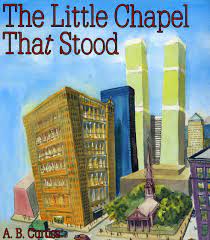

“The Little Chapel That Stood” by A.B. Curtiss; art by Mirto Golino
As we pass the 20th Anniversary of the unimaginable horrors of 9/11, I thought of a quote from Fred Rogers of “Mr. Rogers’ Neighborhood.” His mother told him in his youth that when bad things happen, there also will always be helpers:
“Always look for the helpers.”
And, as I thought of a blog for a book that speaks to children of solace, hope and helpers, while not sidestepping the tragedy of that day and the days that followed, I chanced upon this one. As the events in New York unfolded at the Twin Towers, on September 11, 2001, there was and is a chapel not 100 yards from the soon-to-be-toppled towers that were under attack.
It is called St. Paul’s Chapel, built in 1766 and has come to be known as The Chapel That Stood. It appears that title is a nod to the children’s picture book classic, “The Little Engine That Could” By Watty Piper. Both picture books speak of determination and resilience in the face of many difficulties; these are sorely needed and helpful skill sets for children in the chaotic culture they face today.
On September 11, 2001, fireman flung their shoes on the fence of this chapel as they and others raced to aid the people trapped inside the burning towers.
The chapel withstood the collapse of the Twin Towers and provided in the days and weeks that followed, a place of comfort and peace for the workers, as they worked at the rubble of the Twin Towers that came to be known as “The Pile.”
The book speaks of sadness coupled with unimaginable heroics allowing young readers to come away with a sense of the reality of the event, but also sustained by the grit and determination of the helpers and true heroes that ran to, not from, the Twin Towers on September 11, 2001.
The book has been used by schools as a vehicle to open discussion on a very difficult event for young readers to process.
This picture book by A.B. Curtiss, a poet and essayist, coupled with the art of Mirto Golino, has done a fine job presenting this life-changing event for our country in a balanced way, via this important vehicle for processing it for young ones.
Ms. Curtiss’ work has appeared in The New York Times, The Boston Globe and USA Today. She is also a board-certified cognitive behavioral therapist and a licensed family and child therapist in California.
The book is endorsed by the Smithsonian Institution which calls it ” a wonderful work of children’s literature that balances fact with an uplifting message.”
It is a difficult book to find as it was printed in 2003 and copies are rare and expensive, so I would strongly encourage the publisher, Oldcastle Publishing, to perhaps pursue a reprint for young readers, so this beautiful book can find the wider audience it deserves.
Linking the past of the historical perspective of St. Paul’s from its 1766 beginnings to the succor and comfort it provided on 9/11 and into the future, is testimony of why its story found in “The Chapel That Stood” is used as a beacon of hope during the devastation of that day and the eight months of cleanup that followed.
The chapel was a place where workers could rest, sleep and have a hot meal.
Chester Johnson, a poet who served on the governing board of the Trinity church which operates the chapel said when referring to the chapel:
It stood. Not a window broken. Not a stone dislodged. It stood, when nothing else did. It stood when terrorists brought September down.”
